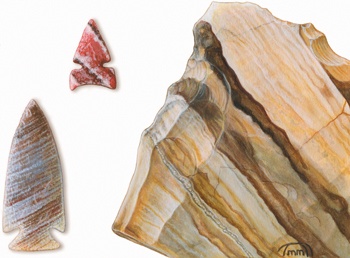Standing on a red bluff overlooking the Canadian River in the Texas Panhandle, I can feel them around me: the spirits of those who had walked this land for thousands of years before. I hear their whispers in the wind. “Learn from us,” they seem to say. “Respect the land, honor the earth as you would your mother who gave you life and provides for your needs.”
The wind blows most days on top of the bluff; today the weather is warm and the wind is gentle, welcome. Colorful stones litter the ground—large chunks and small, sharp slivers—residue of centuries of quarry work at a place likened by writer Ed Syers to the Pittsburgh of prehistoric America, where tool-makers crafted the necessities of life out of rock uniquely suited to the purpose.
This area, which is now the Alibates Flint Quarries National Monument in Potter County, is the only such site in Texas. The 1,079 acres making up the monument were set aside in 1965.
The variegated stone found at Alibates is sometimes referred to as having “bacon-marbling” because it resembles a slice of bacon. This is a marking distinctive to Alibates. Alibates stone embodies the color qualities of a Texas sunset: blue, grey, white, yellow, pink, maroon, red, orange-gold and a deep purplish-blue. While we may call these pieces of stone “flint,” Dr. Eileen Johnson, Director of Lubbock Lake Landmark, an archaeological and natural history preserve, says that is a misnomer.
“The material is not flint but chert, and more specifically an agatized dolomite. The process to determine whether a specific piece of chert is Alibates is basically one of visual identification and comparison with known pieces,” Johnson says.
Huge outcroppings of colorful stone can be found near the depressions that mark the Alibates quarry pits. These surface stones were not suitable for mining since they were exposed to the weather, and the quality of tools made from them would be poor. Below ground, the chert was of a higher quality. Much of the rough work on a quarried stone was done on-site, since every piece had to be carried back down the hill, where it would be turned into a finished tool (a knife, scraper or spear point) for personal use or for trade with other native peoples along the Canadian River.
The chunks of stone had to be knapped, broken into smaller pieces and shaped into a useable tool. Two separate functions are involved: percussion, striking flakes from the core; and reduction, further shaping the stone by pressing small pieces away with a soft tool, usually the tip of an antler. Flintknappers are artists; they bring a vision, a mental image of the tool inside, to their work.
In much the same way as a diamond cutter, a flintknapper strikes the first blow with a rock that is much harder than the chert—and the blow must be precise. The stone is further refined by swift strokes with the rock. Working quickly and skillfully, the knapper then sculpts the stone with an antler tip or other tool, chipping off flakes until the desired shape appears.
It is thought by many that people whose ancestors crossed a land bridge from Siberia to Alaska first inhabited the Southern Plains during the last Ice Age. While we cannot know some things for certain, generations of archeologists, anthropologists and geologists examined the evidence, and like a jigsaw puzzle, put together their collective knowledge to make a picture of history.
Evidence from ruins near the Alibates quarry site and elsewhere along the Canadian River valley suggests that the Antelope Creek people, who built their homes close to springs or near the river where they cultivated crops on a small scale, moved there about 1,000 years ago. While hunting and gathering were still a major part of their lives, mining the quarries for the precious stone was of primary importance. As the people became more settled, they could exchange Alibates chert and bison products for pottery, jewelry, pipes and other items from groups in the southwest and the north.
The remains of two of the villages of the Antelope Creek peoples still exist within the confines of the monument area. Artifacts discovered at the site indicate that the villagers disappeared around 1450. Much like the ancient Maya culture of Mexico and the pueblo dwellers of New Mexico, they just vanished.
Wes Phillips of the Hutchinson County Historical Museum in Borger says, “While we don’t know for certain why they left, we do have some clues. We know that some of the houses burned about the time the people left here. There may also be indications of a drought in the 1400s.”
Projectile points and other tools made of Alibates stone have been found as far away as Montana, Central Mexico and the Mississippi River. Archeologists have pondered over this wide dispersement, and while it may have been generally due to trading activity, we cannot forget the mobility of the far-ranging, horse-borne Plains Indians.
Activity at the quarries can be dated as far back as 12,000 years, the National Park Service says, and appears to have ended around 1870 when most of the Plains Indians had been removed to Oklahoma.
That colorful piece of flint you found after a dust storm might have come from the Alibates quarries. Johnson believes that recording where an artifact (arrowhead, piece of flint, etc.) is found is important information that should be preserved. Anyone finding such material can report it to the Texas Historical Commission in Austin. Make an accurate note of where you found the artifact(s) and take a photo, if possible (include an object to indicate scale). Remember that it is unlawful to remove an artifact from any national park or monument as well as any property belonging to the State of Texas.
Katherine Kelly, a member of South Plains Electric Cooperative, is a Lubbock-based freelance writer.


